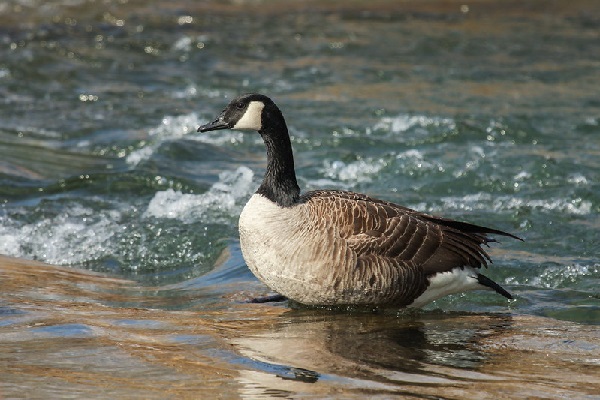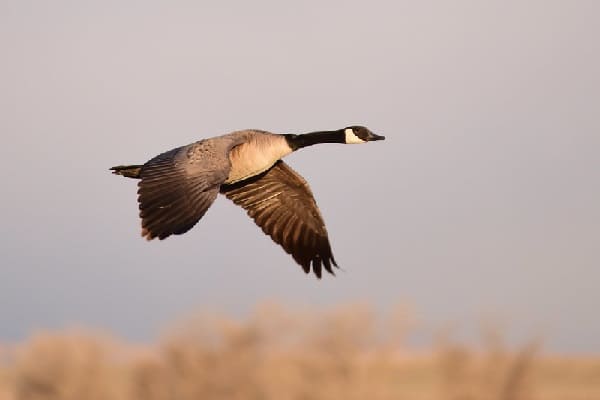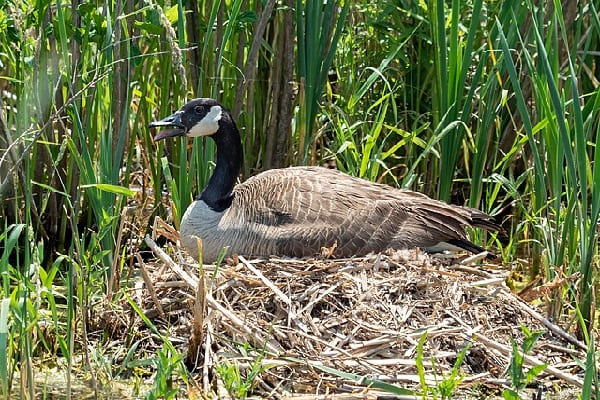
Canada geese are a common sight in many parts of North America, and their distinctive honking calls can be heard from miles away. These large waterfowl are known for their distinctive black and white markings and their impressive wingspan that can reach up to six feet. Canada geese are social birds that typically form pairs during the breeding season, with the male goose often displaying aggressive behavior to protect his mate and their offspring.
In this context, it is interesting to explore the behavior of Canada geese in more detail, particularly when it comes to the differences between male and female geese. By examining the behavior of these birds in the wild, we can gain a better understanding of their social dynamics and the role that aggression plays in their mating and reproductive strategies.

Feeding Behavior
Feeding behavior is an essential aspect of the life cycle of Canada geese. These birds have a diverse diet, which includes both plant material and animal matter. For example, they may feed on a wide range of aquatic plants, such as grasses, sedges, and algae, as well as grains like wheat and corn. They also consume insects, small fish, and other aquatic invertebrates.
The feeding behavior of Canada geese varies depending on the species and their habitat. For example, the giant Canada goose, a subspecies of Canada goose, is known for its grazing habits, which involve feeding on grasses and other plant material in large open areas. They are also known to forage in agricultural fields, where they can consume grains and other crops.
The bill of Canada geese is a remarkable adaptation that enables them to efficiently forage for food in their natural habitat. Most Canada geese have a specialized bill that is flat and wide, with serrated edges that allow them to filter small food items from the water. This unique structure is particularly effective at trapping aquatic plants and other small invertebrates that Canada geese rely on for food.

Social Behaviour
Social behavior is a fundamental aspect of the life of Canada geese. These birds are highly social animals, forming complex social structures and engaging in various social behaviors. Some important aspects of Canada geese social behavior include:
- Monogamous Pairs: Canada geese form monogamous pairs and mate for life. The pair will fiercely defend their nest and young against other geese or predators. The female goose is typically responsible for incubating the eggs and caring for the young, while the male goose takes on the primary responsibility of defending the nest and foraging for food.
- Nest Site Selection: Canada geese are very selective about their nest site, and they will often return to the same location year after year. They prefer nesting near water, on islands or peninsulas where they can defend their young from predators.
- Communication: Geese often engage in social behaviors such as preening, honking, and head-bobbing as a way of communicating and maintaining their social bonds. They are known to communicate through a range of vocalizations, including honking and hissing.
- Group Living: Canada geese are social animals and often live in large groups, particularly during the winter months when they form flocks. These flocks can number in the hundreds or even thousands of birds. One downside to their group living is the large amounts of goose droppings which can accumulate in areas where they congregate.

Migratory Behavior
Migratory behavior is a well-known aspect of the life of geese, and it is particularly important for wild populations, but also occurs in some domesticated breeds. Some important aspects of geese migratory behavior include:
- Navigation: Geese are known to navigate using a combination of visual landmarks, the sun, and the earth’s magnetic field. They also use their memory to recall the migratory routes and stopover sites that they have used in previous years. During migration, geese often fly in a distinctive “V” formation, which is thought to help reduce air resistance and save energy.
- Feather Adaptations: Geese have specialized body and flight feathers that help them to migrate more efficiently. Their body feathers are thick and insulating, which helps them to stay warm during long flights over cold climates. Their flight feathers are strong and sturdy, with sharp edges that help to reduce air resistance and increase lift. These adaptations allow geese to fly at high altitudes and for long distances.
- Social Behavior: Geese typically migrate in large flocks, with dominant birds leading the way and subordinate birds following. During migration, geese will often stop over at resting sites to refuel and rest. They are known to be highly social during migration, and will often call to one another to stay in contact and maintain their flock cohesion.
Migratory behavior is an essential aspect of the life of geese, allowing them to move to areas with more abundant food resources and suitable breeding sites. Their specialized feather adaptations and social behavior enable them to navigate efficiently and safely during migration.

Reproductive Behavior
Reproductive behavior is a critical aspect of the life of geese, as it ensures the survival and growth of the population. Some important aspects of geese reproductive behavior include:
- Nesting Season: Geese typically mate during the spring, and the nesting season begins shortly afterward. During this time, geese will establish nesting sites, usually on the ground or on the water, where they will lay their eggs. The female goose is responsible for incubating the eggs, while the male goose provides protection and forages for food.
- Incubation: Goose eggs typically take about a month to hatch, and during this time, the female goose will remain on the nest, only leaving briefly to forage for food. Once the eggs hatch, the young birds are able to swim and forage for themselves almost immediately, but they will stay close to their parents for protection.
- Parenting/Parental Care: Both male and female geese play an active role in caring for their young, including protecting them from predators, teaching them to forage and swim, and keeping them warm and dry. Young geese will stay with their parents for several months until they are old enough to join flocks of other geese.

Aggressive Behavior
Aggressive behavior is an important part of the social dynamics of geese, and it is especially common during the breeding season. While geese are generally not aggressive towards humans unless they feel threatened, it is important to be aware of their behavior and give them plenty of space during the breeding season, especially in urban areas.Some important aspects of goose aggressive behavior include:
- Loud Honking: Geese often use loud honking as a warning sign to potential threats, such as predators or humans. The honking is a way of alerting other geese in the area, and it can also serve as a deterrent to predators.
- Defending Nest Sites: During the breeding season, geese can become highly territorial and will aggressively defend their nesting sites and young against perceived threats. This can include attacking other animals or humans that get too close to their nests.
- Urban Areas: Geese can be found in a wide range of habitats, including urban areas, where they may come into contact with humans more frequently. In some cases, this can lead to conflicts, as geese become aggressive towards humans who are perceived as a threat to their nests or young.
Need Help With Geese On Your Property?
If you have issues with geese on your property, such as golf courses or urban areas, AAAC Wildlife Removal Services can help. Our team of experts is highly trained in handling geese and can provide safe and effective solutions to address your concerns. We understand that geese can be a nuisance, especially when they form large family groups and start to exhibit aggressive behavior.
Our team can help to remove geese from your property using humane and ethical methods, and we can also provide recommendations for preventing geese from returning to your property in the future. At AAAC Wildlife Removal Services, we are committed to providing the highest quality service to our customers. Our team of experts is available to answer any questions you may have and provide a customized plan to meet your needs. Contact us today to learn more about our geese removal services and how we can help you address your geese-related concerns.
Final Thoughts
Geese are fascinating animals with unique behaviors and social structures. While they are a common sight in many parts of the world, in recent years there have been concerns about overpopulation, especially in urban areas.
It is important to understand the behaviors of geese in order to coexist with them in a safe and respectful way. Steps can be taken to reduce the number of geese in urban areas, such as the implementation of habitat modification or the use of humane geese removal services. However, it is also important to remember the ecological role that geese play in their natural habitats.
Overall, geese are an important part of our ecosystem, and their unique behaviors and social structures make them fascinating animals to observe. From the majestic flights of domestic geese to the tender care of young goslings, there is much to learn and appreciate about these remarkable creatures.







